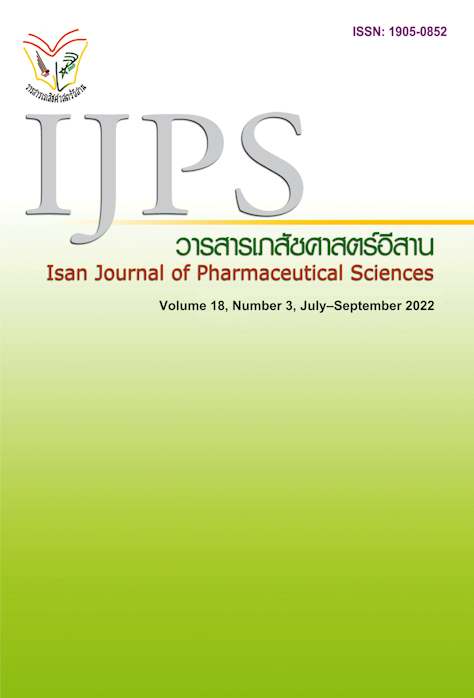Taste-masking of pills by coating with a wax emulsion made from Calathea lutea
Main Article Content
Abstract
The wax covering the leaf of Calathea lutea is a promising naturally resourced material and the use of this natural wax, as a pill coating, requires investigation. This study determined the required hydrophilic-lipophilic balance (HLB) values of this wax, to formulate both the most stable emulsion and the most effective taste-masking preparation for human use. Materials and method: The wax from C. lutea was prepared in a series of six emulsion formulations, with HLB values ranging from 9 to 14, using the beaker method. The optimal required HLB value was determined by using microscopic droplet size analysis. Bitter traditional herbal pills (made from Andrographis paniculata) were then coated with the optimal emulsion formulation in order to evaluate the masking of the bitter taste in healthy volunteers. Results: The results revealed that an emulsion formulation, with the required hydrophilic-lipophilic balance (HLB) of 12, was the most stable and was suitable for coating the bitter herbal pills. In a sensory evaluation in healthy participants in term of onset time exposed bitter taste, the formulation effectively masked the taste of bitter traditional herbal pills when compared to the uncoated pills. The physical characteristics of its coating layer were acceptable. Conclusion: This study suggests that an emulsion made from the wax of C. lutea can effectively mask the bitterness of the andrographis pill. This natural wax material can therefore be used as an alternative pill coating in pharmaceutical preparations.
Article Details

This work is licensed under a Creative Commons Attribution-NonCommercial-NoDerivatives 4.0 International License.
In the case that some parts are used by others The author must Confirm that obtaining permission to use some of the original authors. And must attach evidence That the permission has been included
References
Amita N, Kandarapu R, Garg S. An update on taste masking technologies for oral pharmaceuticals. Ind J Pharm Sci 2002; 64(1):10-7.
Aulton ME, editor. Pharmaceutics: The science of dosage form design. 2nd ed. London, England: Churchill Livingstone; 2001.
Bettman MJ, Percel PJ, Powell TC. Effervescent microcapsules. US Patent. Patent No. 5,709,886., 1998.
Borodkin S, Sundberg DP. Polycarboxylic acid ion-exchange resin adsorbates for taste coverage in chewable tablets. J Pharm Sci 1971; 60(10):1523–7.
Dubois V. Reverse vesicle containing a hydrophobic phase. Patent. European Patent No. EP1905425 A1, 2008.
Felton LA, editor. Remington: Essentials of pharmaceutics. London, England: Pharmaceutical Press; 2013.
Gadhave A. Determination of hydrophilic-lipophilic balance value. IJSR 2014; 3(4): 573–575.
Garcia-Bailo B, Toguri C, Eny KM, El-Sohemy A. Genetic variation in taste and its influence on food selection. OMICS 2009; 13(1):69–80.
Govaerts R. World checklist of seed plants. MIM; 1999.
Griffin WC, Lynch MJ, Lathrop LB. Emulsions, part one. Drug Cosmet Ind 1967; 101(4):41.
Gurr MI, Harwood JL, Frayn KN, et al. Lipids: Biochemistry, biotechnology and health. 6th ed. Nashville, TN: John Wiley & Sons; 2016.
Hussein AA, Ghareeb MM, Hussain RAA. Preparation and characterization of meloxicam colon targeted coated tablets. Int j pharm 2013; 5(1):338–342.
ICI Americas, Inc. The HLB system: a time-saving guide to emulsifier selection. New York: ICI Americas Inc.; 1994.
Institute of food technologists-sensory evaluation division. Minutes of division business meeting. Chicago, US: Institute of Food Technologists; 1975.
Jafari SM, Assadpoor E, He Y, et al. Re-coalescence of emulsion droplets during high-energy emulsification. Food Hydrocoll 2008; 22(7):1191–1202.
Kaevatana Y. Pharmaceutical industry and export development Guidelines. Bangkok, Thailand: Department of international trade promotion, Ministry of commerce; 1998.
Lawless HT. Quantitative sensory analysis: psychophysics, models and intelligent design. Hoboken, NJ: Wiley-Blackwell; 2013.
Leon L, Herbert AL, editors. The theory and practice of industrial pharmacy. 2nd ed., Bombay, India: Varghese Publishing house; 1991.
Levius HP, Drommond FG. Elevated temperature as an artificial breakdown stress in the evaluation of emulsion stability. J Pharm Pharmacol 1953; 5(10):743–56.
Malterud KE, Wollenweber E, Gómez LD. Notizen: The wax of Calathea lutea (Marantaceae). Z Naturforsch C 1979; 34(1–2):157–8.
Mauger JW, Robinson DH. Coating technology for taste masking orally administered bitter drugs. Patent. U.S. Patent No.5,728,403, 1998.
Nakamura T, Tanigake A, Miyanaga Y, et al. The effect of various substances on the suppression of the bitterness of quinine-human gustatory sensation, binding, and taste sensor studies. Chem Pharm Bull (Tokyo) 2002; 50(12):1589–93.
National Academy of Sciences. Underexploited tropical plants with promising economic value. Washington, DC: National Academy of Sciences; 1979.
Office of Agricultural Economics. Agricultural statistics of Thailand crop year 2019. Bangkok, Thailand: Ministry of Agriculture and Cooperatives; 2018.
Sakr AD, Alanazi FK. Oral solid dosage forms. In: Felton L, editor. Remington-essentials of pharmaceutics. London: Pharmaceutical Press; 2013. 581–610.
Schnaare RL, Prince SJ. Metrology and pharmaceutical calculations. In: Felton L, editor. Remington-essentials of pharmaceutics. London: Pharmaceutical Press; 2013. 101–132.
Sherman P. General properties of emulsions and their constituents. In: Sherman P, editor. Emulsion Science. London: Academic Press; 1968. 157–162.
Sohi H, Sultana Y, Khar RK. Taste masking technologies in oral pharmaceuticals: recent developments and approaches. Drug Dev Ind Pharm 2004; 30(5):429–48.
Standley PC, Steyermark JA. Marantaceae. In: Flora of Guatemala- volume 24, part III. Chicago: Chicago natural history museum press; 1952.
Subramanian R, Zaini Asmawi M, Sadikun A. A bitter plant with a sweet future? a comprehensive review of an oriental medicinal plant: Andrographis paniculata. Phytochem Rev 2012; 11(1):39–75.
Toro-Vazquez JF, Morales-Rueda JA, Dibildox-Alvarado E, et al. Thermal and textural properties of organogels developed by candelilla wax in safflower oil. J Am Oil Chem Soc 2007; 84(11):989–1000.


